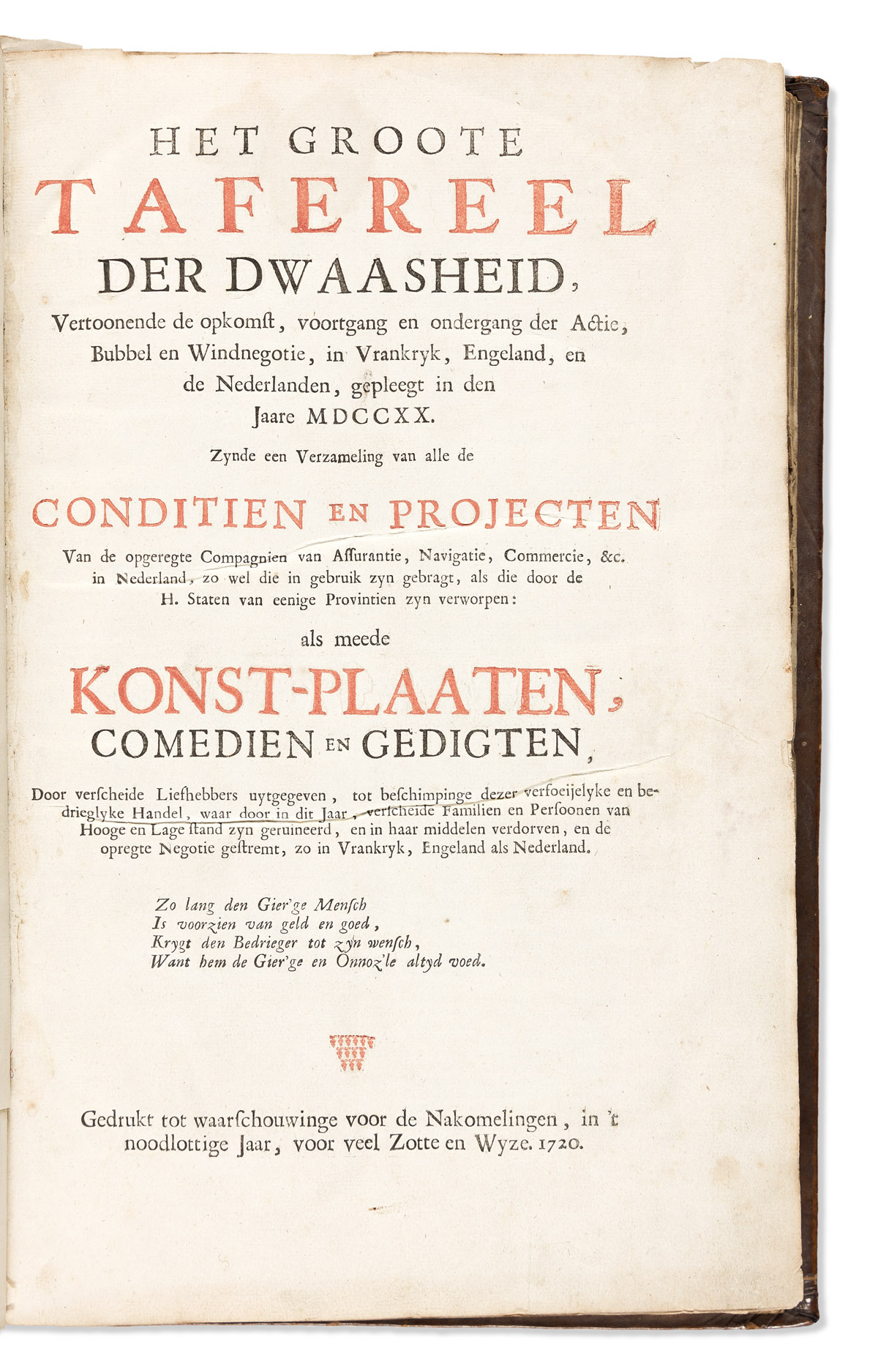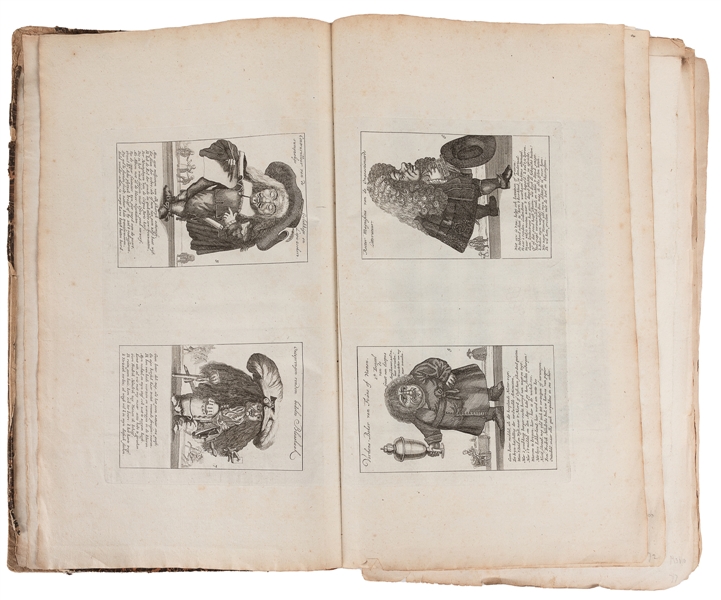SOUTH SEA BUBBLE]. Het Groote Tafereel der Dwaasheid, Vertoonende de opkomst, voortgang en ondergang der Actie, Bubbel en Windnegotie, in Vrankryk, Engeland, en de Nederlanden, gepleegt in den Jaare MDCCXX . [Amsterdam: D. Onder de Linden], 1720.
SOUTH SEA BUBBLE]. Het Groote Tafereel der Dwaasheid, Vertoonende de opkomst, voortgang en ondergang der Actie, Bubbel en Windnegotie, in Vrankryk, Engeland, en de Nederlanden, gepleegt in den Jaare MDCCXX . [Amsterdam: D. Onder de Linden], 1720. 2 o (380 x 250 mm). Title in red and black. Engraved plate list. 77 copper engraved plates, many folding (plate 8 torn along fold, a few other shorter tears, last plate with marginal stain just crossing image border). Contemporary gilt-panelled mottled calf, covers with central gilt eagle tool enclosed within an eight-pointed star, the inner panel with floral corner pieces, spine gilt and decorated with the same eagle tool in each compartment (rebacked preserving original spine panel, some repairs at corners); cloth folding case. AN EARLY ISSUE of this biting and vulgar satire on the Mississippi and South Sea Bubbles and an extraordinary visual record of the first banking crash, showing the shocking effects of the South Sea Bubble in France, England and Holland, and placing John Law (1671-1729), with his Mississippi company scheme, squarely at the centre of the disasterous chain of events. "The engravings, which illustrate the rise and fall of the great speculation, are full of humor; many of them are exceedingly ludicrous, and some very obscene" (Sabin). The text provides the charters of important companies floated in various Dutch cities during the period of bubble fever, and the plates expose the principals of these companies to merciless ridicule. "The combination of such prosaic data with the numerous satirical engravings, with the reprint of comedies and satires, and with a description of bubble playing cards offers the student a unique historical document, the like of which was not thrown up by the speculative manias in either France or England" (Cole, The Great Mirror of Folly... An Economic-Bibliographical Study , p.1). the Tafereel is perhaps an important factor in the slow development of modern corporate organization. "Against the joint-stock manner of business arrangements were thrown the fears engendered by this popular portrayal of the downfall of the 'windnegotie.' Possibly a mere book was really an economic force" (Cole, p.20). The compiler, probably a bookseller in Amsterdam, hoped to profit from the suspicion against joint-stock ventures which arose after the famous crash. He collected much of the ephemeral material satirizing the schemes of John Law and some English merchants to purchase trading monopolies with money from share-holders. The material is presented in the language of the street. The compiler continued to sell a few copies of the Tafereel until at least 1780. He constantly altered the composition, omitting some sections of text or plates, or adding supplementary plates from his stock. Copies vary in the number of plates from sixty to eighty-five. In this copy, the seventy-four plates of the original collection have been supplemented with three early engravings. Bell G-816; Goldsmiths 5879; Kress 3217; Sabin 28932.
SOUTH SEA BUBBLE]. Het Groote Tafereel der Dwaasheid, Vertoonende de opkomst, voortgang en ondergang der Actie, Bubbel en Windnegotie, in Vrankryk, Engeland, en de Nederlanden, gepleegt in den Jaare MDCCXX . [Amsterdam: D. Onder de Linden], 1720.
SOUTH SEA BUBBLE]. Het Groote Tafereel der Dwaasheid, Vertoonende de opkomst, voortgang en ondergang der Actie, Bubbel en Windnegotie, in Vrankryk, Engeland, en de Nederlanden, gepleegt in den Jaare MDCCXX . [Amsterdam: D. Onder de Linden], 1720. 2 o (380 x 250 mm). Title in red and black. Engraved plate list. 77 copper engraved plates, many folding (plate 8 torn along fold, a few other shorter tears, last plate with marginal stain just crossing image border). Contemporary gilt-panelled mottled calf, covers with central gilt eagle tool enclosed within an eight-pointed star, the inner panel with floral corner pieces, spine gilt and decorated with the same eagle tool in each compartment (rebacked preserving original spine panel, some repairs at corners); cloth folding case. AN EARLY ISSUE of this biting and vulgar satire on the Mississippi and South Sea Bubbles and an extraordinary visual record of the first banking crash, showing the shocking effects of the South Sea Bubble in France, England and Holland, and placing John Law (1671-1729), with his Mississippi company scheme, squarely at the centre of the disasterous chain of events. "The engravings, which illustrate the rise and fall of the great speculation, are full of humor; many of them are exceedingly ludicrous, and some very obscene" (Sabin). The text provides the charters of important companies floated in various Dutch cities during the period of bubble fever, and the plates expose the principals of these companies to merciless ridicule. "The combination of such prosaic data with the numerous satirical engravings, with the reprint of comedies and satires, and with a description of bubble playing cards offers the student a unique historical document, the like of which was not thrown up by the speculative manias in either France or England" (Cole, The Great Mirror of Folly... An Economic-Bibliographical Study , p.1). the Tafereel is perhaps an important factor in the slow development of modern corporate organization. "Against the joint-stock manner of business arrangements were thrown the fears engendered by this popular portrayal of the downfall of the 'windnegotie.' Possibly a mere book was really an economic force" (Cole, p.20). The compiler, probably a bookseller in Amsterdam, hoped to profit from the suspicion against joint-stock ventures which arose after the famous crash. He collected much of the ephemeral material satirizing the schemes of John Law and some English merchants to purchase trading monopolies with money from share-holders. The material is presented in the language of the street. The compiler continued to sell a few copies of the Tafereel until at least 1780. He constantly altered the composition, omitting some sections of text or plates, or adding supplementary plates from his stock. Copies vary in the number of plates from sixty to eighty-five. In this copy, the seventy-four plates of the original collection have been supplemented with three early engravings. Bell G-816; Goldsmiths 5879; Kress 3217; Sabin 28932.




.jpg)
.jpg?height=400)



.jpg)

.jpg)


Testen Sie LotSearch und seine Premium-Features 7 Tage - ohne Kosten!
Lassen Sie sich automatisch über neue Objekte in kommenden Auktionen benachrichtigen.
Suchauftrag anlegen